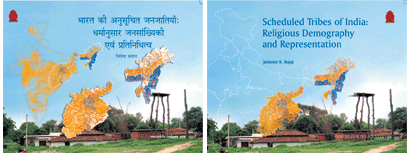
Download PDF in English and Hindi
Scheduled Tribes of India:
Religious Demography and Representation
There are 84 million Scheduled Tribe persons in India as counted in the Census of 2001. Of them, about one third are in the Central Indian region comprising Jharkhand, Chhattisgarh, Orissa and some of the contiguous districts of Bihar, Madhya Pradesh, Maharashtra and Andhra Pradesh. Another about a third are in the western region comprising Rajasthan, Gujarat, and several districts of Madhya Pradesh and Maharashtra. There are about 8 million Scheduled Tribes in parts of Andhra Pradesh, Karnataka, Tamil Nadu and Kerala. About 2 million Scheduled Tribes are in the northern region of Jammu and Kashmir and the adjoining districts of Himachal Pradesh and Uttarakhand. The remaining about 14 million Scheduled Tribes are in the eastern region: 4 million in West Bengal, 3 million in Assam and about 7 million in the other six states of the Northeast.
A predominant majority of the Scheduled Tribes in India continue to follow their traditional religion; nearly 75 million of the 84 million STs are followers of either Hinduism, Buddhism or one of the many sects like Sarna Dharma, Sari Dharma and Doni Polo, etc. But there are also about 1.2 million Muslims and nearly 8 million Christians among them. The Muslim STs are mainly in Jammu and Kashmir; and, to a lesser extent, in Maharashtra and Lakshadweep. Of 8 million Christian STs, 5.5 million are in the Northeast; of them, about 0.3 million are in Assam and Tripura, and 5.2 million in the remaining five Northeastern States. Among about 74 million Scheduled Tribes outside the Northeast, there are only 2.5 million Christians. Of them, about 2 million are in the three Central Indian States of Jharkhand, Chhattisgarh and Orissa; these three States have a combined ST population of about 22 million.
Though there are so few Christians among the Scheduled Tribes of India, especially outside the Northeast, yet they command a disproportionately large share of the ST positions in the Central Services. This is achieved mainly by assigning a high number of ST places in the Central Civil Services to the STs of the Northeastern States, most of whom are Christian. But, even in the other States of India, which have relatively low ST representation in the Central Civil Services, Christians manage to occupy a disproportionately high share. In the State Civil Services also, the number of ST positions filled by the Christian STs is much higher than what would be their fair share on the basis of their proportion in the ST population of the State.
Here, we present data on the share of STs and Christian STs of the Northeastern States in the Indian Administrative Service based on the Civil List as on January 1, 2009. We compare the situation of the Northeast with three States of Central India, Jharkhand, Chhattisgarh and Orissa, each of which has ST population comparable to the whole of Northeast excluding Assam. The difference in the number of ST IAS officers from the Northeast and the other three States that we have considered is striking. The Northeastern States (excluding Assam) have ST population of about 7 million, 5.2 million of whom are Christian. The number of ST officers of Northeastern domicile in the Civil List is 111, of whom 96 are Christian. There are another 19 ST IAS officers from Assam, of these 9 are Christian. The ST population of Assam is 3.3 million with 3 lakh Christians among them. On the other hand, Jharkhand, Chhattisgarh and Orissa together accommodate nearly 22 million STs, of whom less than 2 million are Christian. The number of ST officers in the Civil List from these three States together is 17, and 8 of them are Christian.
The data presented here deals with only a few States and mainly with the Indian Administrative Service. We are conscious that to get a complete picture, it is important to analyse data from all States and many other Central and State Services. However, the data of the representation of STs and Christian STs from the Northeast and from the three States of Jharkhand, Chhattisgarh and Orissa points to such gross inequity between the two regions and between the Christians STs and others that we have thought it appropriate to publish this data without waiting for the compilation of the larger picture.
The inequity prevailing between the Christian STs and those who have continued to follow their traditional religion came up for discussion in the Parliament in the late sixties, largely through the efforts of Sri Kartik Oraon; the issue whether the Christian STs can lay claim to the privileges granted in the Constitution for the underprivileged and primitive Tribes has also been adjudicated by the Supreme Court on a couple of occasions. In an Appendix to this volume, we have summarised the Parliamentary debate of the late sixties, and the two Supreme Court judgements.
We have identified the ethnic and religious identity of officers in the Civil List by interacting with knowledgeable persons in the public life of different States who in many cases are personally acquainted with the officers from their States and their families. We are thankful to colleagues from the Janjati Suraksha Manch for their help in this task.
I acknowledge the contribution of my young colleague, Amit Bansal, in painstakingly compiling the GIS maps in this volume.
November 24, 2011 Jatinder Bajaj



